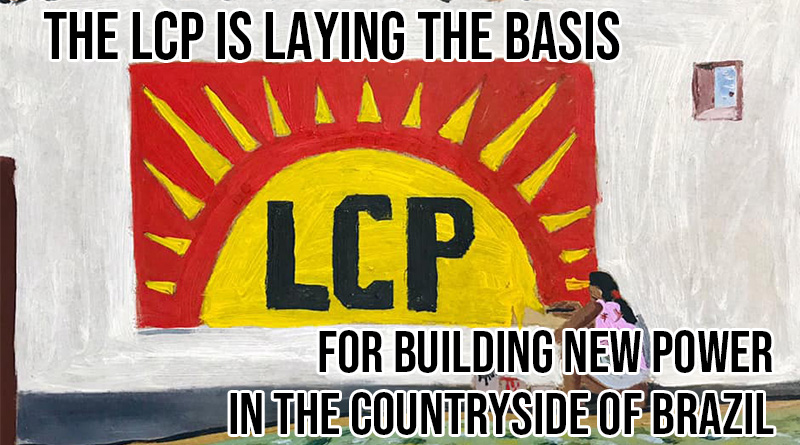The LCP is laying the Basis for Building New Power in the Countryside of Brazil
Our previous article described the history of the peasant struggle for land in Brazil. Since 1995 that struggle for land has been divided onto two distinct roads: the one of opportunists, meaning the organizations that adopted a passive posture, waiting for the government or foreign NGO to solve the land issue for them, and the one of revolutionaries, who took their destiny in their own hands and boycotted elections and the sham “democracy,” and organized to build the basis of New Power.
This article will focus on the current situation, on the objective and subjective conditions, and will shed some light on some of the LCP’s achievements.
1. What is the Land Situation today in Brazil?
Who owns the Land in Brazil?
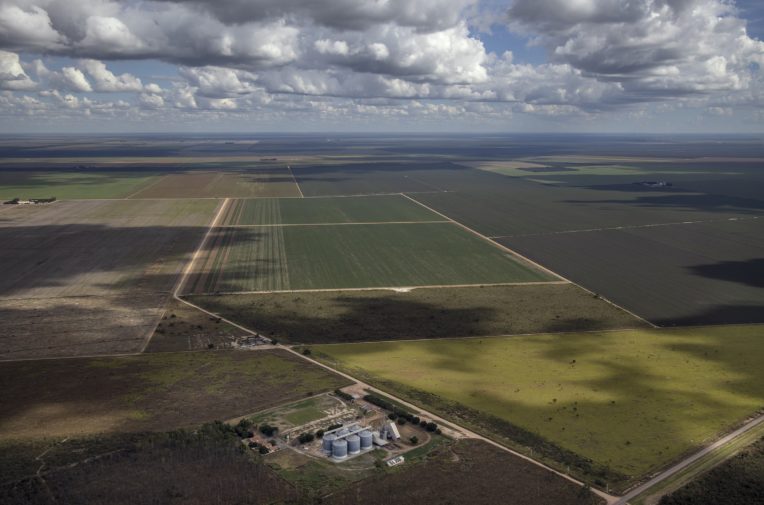
From the 1500 colonization of Brazil to the formal political independence of 1822, land in Brazil was the property of the Portuguese king who gave some noble families the right to occupy and exploit it. “Independence” made those concessions legal rights of property and the ruler of the new Empire of Brazil held the authority to distribute land. The 1889 proclamation of the Republic did not change the ownership of that land. Until now, despite the promises of several presidents, there has been no reform to change this situation. This means that the majority of land ownership in Brazil is the product of a feudal division from colonial times, not on the basis of the people’s needs, but on the basis of friendship with the crown.
This result of this history is that around 2% of the 5.5 million rural properties (more than 400 million hectares), called the latifundio, are concentrated in the hands of an estimated 23,000 landlords who own 48% of the land, to the detriment of more than 5 million families of small landed peasants (91%), who have only 20% of the land (80 million hectares). The landed peasants have properties of a maximum of 100 hectares, with the great majority having at most 40 hectares. 8%, representing the medium properties own a range of 100 hectares to 900 hectares and have 32% or 120 million hectares). 5 million peasant families have no land. This concentration of land is considered one of most unequal in the world and has only accelerated since Lula’s regime with the passage of the Terra Legal, which transferred more than 150 million hectares of public lands to the landlords.
“Landlessness”
The concept of “landlessness” is often used in Brazil to described the situation where a lot of peasants live and cultivate land, called “Posseiros,” (sometimes, for decades or centuries) that belong legally to the latifundio or are public lands. More concerned with the concept of legality than material reality, opportunists described them as “landless” because they don’t hold legal property titles. The revolutionaries simply call this population poor peasants, a class description that is based on the small parcels of lands they cultivate or work on the lands of the landlords through various semi-feudal forms of leasing.
Are there then “landless” peasants in Brazil? Yes, there are peasants who don’t have any land to cultivate, which is why the LCP organizes land seizures throughout the country. However, once a peasant cultivates even one hectare of land, the term “landless” does not reflect reality.
Violence against the Poor Peasants
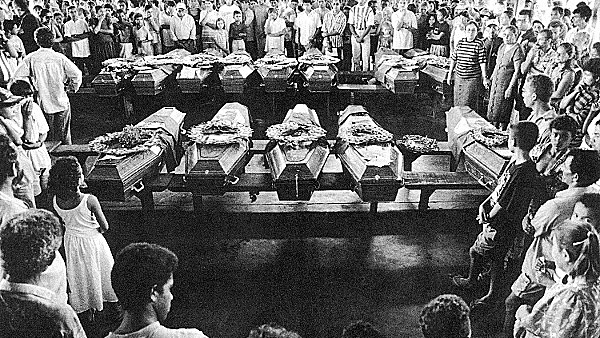 Since the first Quilombo rebellions, the State and the latifundio have collaborated to massacre peasants, and those massacres have never stopped. Since the Battle of Santa Elina in 1995, there have been three other large-scale massacres, in addition to countless targeted assassinations: Eldorado dos Carajás in the State of Pará, in 1996, Colniza in the State of Mato Grosso in 2016, and Pau D’Arco also in the State of Pará in 2017.
Since the first Quilombo rebellions, the State and the latifundio have collaborated to massacre peasants, and those massacres have never stopped. Since the Battle of Santa Elina in 1995, there have been three other large-scale massacres, in addition to countless targeted assassinations: Eldorado dos Carajás in the State of Pará, in 1996, Colniza in the State of Mato Grosso in 2016, and Pau D’Arco also in the State of Pará in 2017.
The massacres continue because the fundamental contradiction of land to the tiller has not been resolved. The misery of the lives of the poor peasants pushes them to seize and occupy land from which they are evicted by violence by the latifundio gunmen. Also, the Brazilian State not only turns a blind eye to the killings (e.g. between 1985 and 1996, 976 peasants were murdered and only seven people were ever convicted for any of the killings according to Amnesty International), but in many cases sends the Military Police to assist the latifundio gunmen. (This was the case in the four massacres listed above.)
During the presidencies of Lula and his successor Rousseff (2003-2016), the violence against poor peasants changed from blind killings to more selected assassinations of poor peasant leaders, indigenous peoples and Quilombo organizations. Today, there are increasing incidences of both assassinations and large-scale massacres.
The National Question
To understand the situation regarding the national question in Brazil, it is necessary to keep in mind that Brazil is a colonial state built through a process of “conquest” (i.e. a genocide). This makes Brazil a multinational state, with many unrecognized and oppressed nations who were made oppressed minorities by the Brazilian state. With an estimated population of 900,000, they are mostly concentrated in the Amazonian forest and share the same “history, language, territory, economic life and culture.”
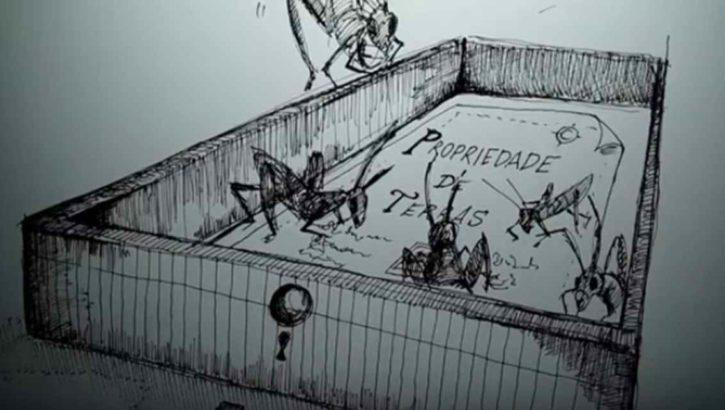
The Quilombos are also facing a brutal process of forced assimilation. They have maintained throughout their tradition of political, military and cultural resistance, their proper culture, separate economic life and well-defined lands that they have occupied for centuries. They also constitute traditional communities.
Those two populations, together with the poor peasants, have the latifundio as their main enemy, and while the opportunist politics deepen the contradictions between them (by giving special rights to one group that forces them into contradictions with the rights of others), the revolutionaries call for the unity of the indigenous, Quilombos and poor peasants to constitute a united front.
While the opportunist Lula promised the “demarcation of lands” to the indigenous people, 14 years of the PT rule actually saw a slowing down of the creation of indigenous reserves, an increase of the exploitation of indigenous lands by latifundio and agribusiness, and a legalization of indigenous land grabbing. This land grabbing is called grilagem in Portuguese, because the landlords use the registry office where properties are registered to fabricate fake ownership documents. In order to make them look old, they put the papers with crickets—grilo in Portuguese—which secretes fluids that give the documents an aged appearance. Much of that land is public land, which the Terra Legal law allowed latifundist to cultivate. This consequently also increased the number of murders of indigenous people, raising it to the level of killings during the military regime.
On the other hand, the revolutionaries’ program to lay the foundation to construct the future New Democratic State, recognizes the right to self-determination (i.e. the right to separate and form their own State) of the indigenous and the special conditions of the Traditional Communities for the remnants of Quilombos, and will work for them to remain united in a single People’s State of a New Democracy with their rights acknowledged.
The Issue of NGOs
There are over 1000 NGOs in Brazil, more than 90% of them present since the military regime started to weaken at the end of the 70s. Due to the misery of the masses produced by the semi-colonialization of Brazil, these NGO have grown quickly, forming a parallel structure to the State and relieving it of the responsibility of some of its functions.
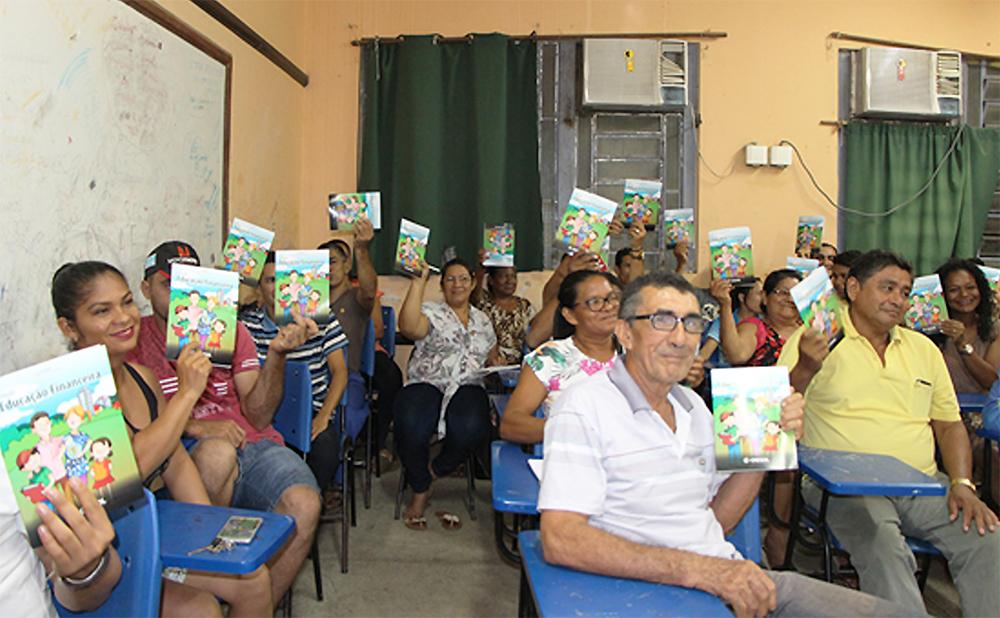
There are NGOs that originate and are financed by foreign countries (i.e. imperialist NGOs), and “domestic” NGOs. This excludes the NGOs that try to portray themselves as “Brazilian” but exist only through funds coming from imperialist countries and therefore embrace the same interests as the overtly foreign ones.
The role of the first is to influence people on political (so-called “democratic”) concerns in order to have an impact on the reforms of the country, as well as to spread foreign imperialist culture. While NGOs sending teachers to Brazil to teach English could be seen as something good, the main intention behind such programs is to train people to communicate (and therefore, to trade) in the language spoken by imperialist forces. In this context, it’s not surprising then that 85% of the US budget for foreign aid goes to NGOs. They also play the role of gathering information regarding the political and socioeconomic situation of the country (most imperialist countries have strict laws regarding reporting obligations).
While the “international” NGOs directly serve the interests of imperialist forces, the “domestic” NGOs serve the interests of different factions of the dominant classes. Their actions are similar to the first.
Both types of NGOs target oppressed groups such as the indigenous, women, favelas and poor peasants, under different pretexts such as: “the defense of Amazonian forest,” “gender equality” or “right to health.” The tactics they use to pacify the people’s anger against semi-colonialism are to promise financial support, or by corrupting some of the community leaders. In reality, their intervention changes nothing about the root causes of the problems of those oppressed and act to prevent people from a necessary rebellion against the latifundio which would change the situation for not just a few but for all the oppressed masses.
2. How Does the LCP Struggle?
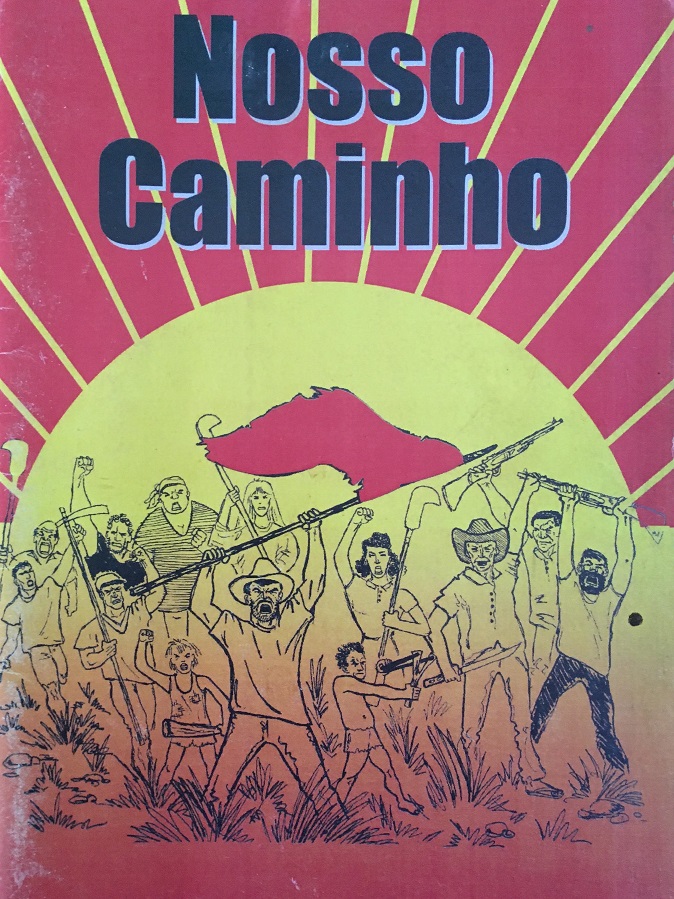 The Poor Peasants’ League established a program called “Nosso Caminho” (Our Path), which contains the concrete steps needed to struggle against the oppression the masses face. Its main difference from the opportunists’ program is that it does not involve political maneuvers or legalistic tactics to reach its goal.
The Poor Peasants’ League established a program called “Nosso Caminho” (Our Path), which contains the concrete steps needed to struggle against the oppression the masses face. Its main difference from the opportunists’ program is that it does not involve political maneuvers or legalistic tactics to reach its goal.
The LCP struggle against the concentration of land by the latifundio is raising the political consciousness of the peasants and their militancy to forcibly occupy their lands. Against landlessness, the LCP launches lands seizures. To prevent violence against and the murder of peasants, the LCP organizes self-defense. Regarding the indigenous and Quilombos, the LCP is building a united front to defend the rights of the people. And to the NGOs, the LCP answers that the people that should take their destiny in their own hands!
From Seizing Land to Collectivization
Since the seed of the occupation of Santa Elina was planted, the revolutionaries have distinguished themselves from the opportunists by showing that they won’t wait for the corrupted State or imperialists to solve the problem of land. Seizure and occupation of lands begun in many parts of the country, continues today. But seizing and distributing land is only the first step of a longer process, because to destroy the latifundio means struggling against the dominant classes (and to their lords, the imperialists), and ultimately private property.
In their program the LCP defined two stages in the cooperation in production, as well as a third, future stage.

- The stage of mutual aid: Once an area is seized and peasant occupation begins, the land is divided into equal parcels, according to the size of the families. Peasants receive property titles that are recognized by the People’s Assembly of the peasants who occupy and their leadership organ, the Committee for the Defense of Agrarian Revolution (CDR), to lay the basis for the construction of the New Power. Each of the peasant families works on their own parcel, but a policy of mutual help is promoted. While the landlords competitively fight amongst each other to advantage the profitability of their own crops, the CDR teaches the peasants that together they can all produce more and benefit from their increased production.

- The stage of cooperatives: Once the notion and practice of mutual aid is deeply rooted in a revolutionary area, it is possible to advance to the stage where peasants agree to pool the land and work on it together. This involves both collective work in the fields, as well as a collective distribution and commercialization of the harvest. It can also mean collective ownership of agricultural machinery such as tractors. Some revolutionary areas are already in this stage.

- The stage of collectivization: This stage is seen as a future perspective, which first requires not only a New Democratic Revolution but also a higher level of consciousness among the peasants.
What is the New Culture?
To raise the level of political consciousness and begin to fight the hegemony of bourgeois and landlord culture by putting socialist principles in practice, the LCP promotes a New Culture in its revolutionary areas.
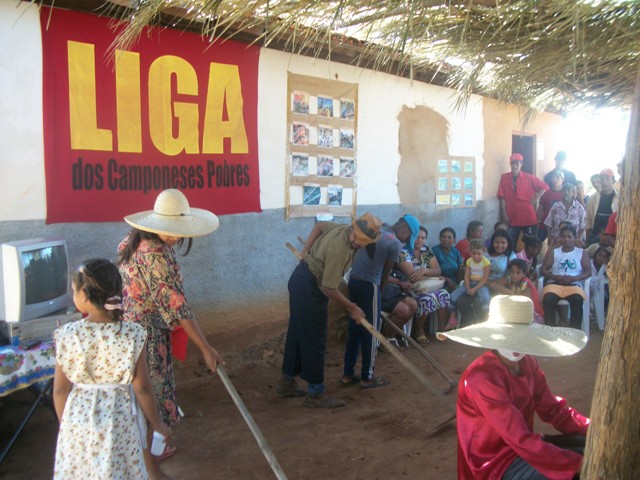 Apart from exercising a military and political occupation, imperialism spreads its decadent culture to pacify the people, look to their oppressors as their saviors and hate their own class. Imperialists hide their propaganda in claiming their promotion of “freedom and democracy” and “morality,” but in reality, their culture promotes exactly the opposite: individualism, racism, sexism, alcoholism, drug addiction, etc.
Apart from exercising a military and political occupation, imperialism spreads its decadent culture to pacify the people, look to their oppressors as their saviors and hate their own class. Imperialists hide their propaganda in claiming their promotion of “freedom and democracy” and “morality,” but in reality, their culture promotes exactly the opposite: individualism, racism, sexism, alcoholism, drug addiction, etc.
To counter this hegemony and introduce socialist relationships and practices, the LCP defined 16 rules of function and discipline in the revolutionary areas. In addition to creating new democratic structures for governance, Articles 6, 7 and 8 speak directly to promoting a new way of living in relation with others in society, i.e. forbidding drug use (including alcohol), discrimination on the basis of race, religion or gender, and prostitution and gambling.
Moreover, the LCP promotes sports, culture (art and literature) and creates structures to encourage them. One of the most fundamental campaigns in the revolutionary areas is the struggle against illiteracy, carried out in the People’s School. Those schools also give courses to raise political consciousness, including analyzing the current situation in Brazil, the world and its contradictions.
Education and Health
The question of the education and health of the families in the revolutionary areas, often far from cities and basic infrastructure, is crucial.
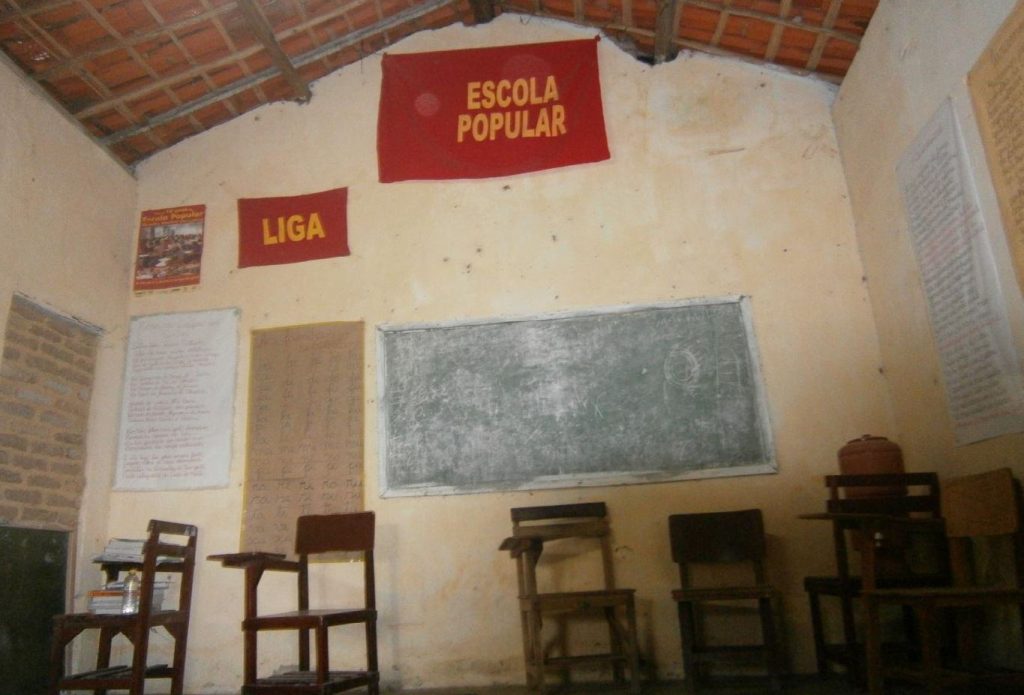 The LCP sees the question of education and health as one of the four fundamental pillars necessary to transform the Brazilian countryside. In its areas, this is carried out through People’s Schools and health clinics. While in a most areas, children still going to state schools, People’s Schools are built to promote a different form of education for people 16 years and older, based on principles of study, work and struggle (i.e. scientific investigation, struggle for production and class struggle). The People’s Schools serve to both reduce illiteracy as well as raise the level of consciousness of the peasant masses.
The LCP sees the question of education and health as one of the four fundamental pillars necessary to transform the Brazilian countryside. In its areas, this is carried out through People’s Schools and health clinics. While in a most areas, children still going to state schools, People’s Schools are built to promote a different form of education for people 16 years and older, based on principles of study, work and struggle (i.e. scientific investigation, struggle for production and class struggle). The People’s Schools serve to both reduce illiteracy as well as raise the level of consciousness of the peasant masses.
Regarding health, the LCP aims to promote a people’s system for prevention and curing of diseases through traditional knowledge of therapies and using medicinal herbs, hygiene measures and sewer systems as the basis for future people’s health clinics.
How are the Revolutionary Areas Protected?
Although the occupied land is proclaimed legal and just by the People’s Assembly and the CDR, the illegal character of the land occupation in the eyes of bourgeois law brings repression. The latifundio who want the peasants to leave “their” lands repress through paid gunmen. The direct repression of imperialism, through the dominant classes leading the State, which sees the growing strength of the peasant movement as a threat to their semi-colonial/semi-feudal exploitation of the Brazilian lands, repress through military, para-military and police violence, as well as with their control of the judicial system. For centuries, the latifundio and the State have been arm-and-arm in perpetuating massacres against the masses and targeted killings of peasant leaders.
While the opportunists believe that it’s enough to organize marches and call the UN to “act” against the killings (missing the point that those responsible for the killings are the same as those who are behind the UN), the revolutionary areas have defined a policy of self-defense.
This policy aims to train all members of each area to defend themselves against frontal attacks (gunmen, military police, etc. in eviction actions), as well as attempts of infiltration. Obtaining information on the enemy’s movements and spreading counter-information is also seen as part of self-defense.
3. The Achievements of a Revolutionary Area in the North of Minas
The line of “Nosso Caminho” was established following the Battle of Santa Elina and was adopted by the revolutionary peasant movement in all of Brazil during the LCP’s first Congress in 2000. We can measure the correctness of its line by observing what concrete gains it has made, taking the achievements of the revolutionary area of the Bridge of the Workers-Peasants Alliance, in the North of Minas as an example.
The Worker-Peasant Alliance Bridge
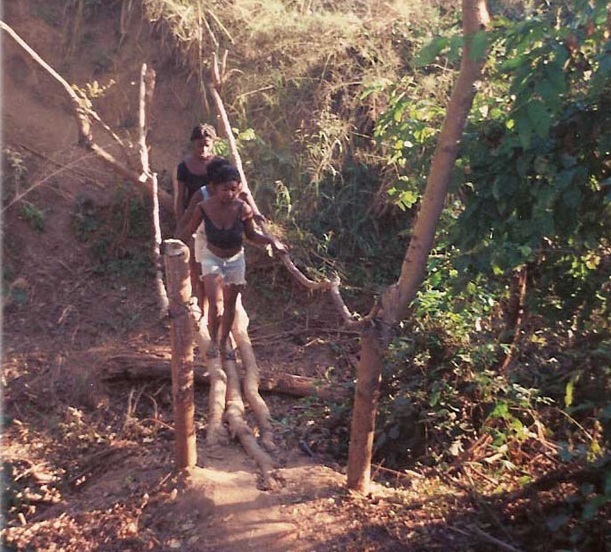 The Bridge of the Workers-Peasants Alliance is in an area between the small cities of Varzelândia and São João da Ponte (North of Minas), which was occupied land in 1998. It is inhabited and cultivated by 35 families under constant threat of eviction. In 2006 LCP comrades organized to solve an issue that had deadly consequences for the children in the area. The area is located near a river that school children have to cross every day to go to school. However, the river never had a real bridge—just three improvised and unstable logs laid over a river that sometimes had a dangerous current when flooded.
The Bridge of the Workers-Peasants Alliance is in an area between the small cities of Varzelândia and São João da Ponte (North of Minas), which was occupied land in 1998. It is inhabited and cultivated by 35 families under constant threat of eviction. In 2006 LCP comrades organized to solve an issue that had deadly consequences for the children in the area. The area is located near a river that school children have to cross every day to go to school. However, the river never had a real bridge—just three improvised and unstable logs laid over a river that sometimes had a dangerous current when flooded.
Following the death of two children who fell and were caught in the current, the mayor of São João da Ponte (from the Workers’ Party, PT), the municipality where nearest village where the school was located, made numerous speeches during his election campaign promising to build a bridge, just as the previous mayors did for decades. The peasants voted with enthusiasm for him. But once he was elected, his promises turned out to be empty; suddenly the project was impossible, because it was too expensive (with an estimate cost of 100,000 reals), and the delegation of peasants that went to the city hall to protest his decision was not even granted a meeting.
The peasants in the area understood through this process that state intervention was not going to solve their problem and that they had to solve it through their own efforts. However, while the peasants were hard-working men and women, they didn’t have the technical skills to build a bridge. How to design it, what materials should be used and what pressure it needed to resist, were questions to which they had no sure answer.
At this time, the slogan of “unity of the workers and peasants” became more than just words, but a real necessity; they would not be able to build this bridge without the collaboration of the workers.
The peasants from the LCP contacted their comrades from the Workers League (Liga Operaia—LO), who quickly understood and conceptualized the work to be done; many were peasants themselves who became landless following latifundio evictions, forced to migrate to the cities in search of work. They understood firsthand all the potential different difficulties of the construction, such as soil erosion, and the protection against flooding. LO Engineers arrived at the site to carefully inspect and measure everything. Their conclusion: it was possible to build a bridge, and the estimated cost of the materials was around 15,000 reals. When the peasants wondered why the mayor estimated the cost at 100,000 reals, the engineers explained how the overestimation of a project was a common way for corrupt politicians to siphon off money for themselves. (How unsurprising it was for them to learn, some years later, about the accusations of corruption against Lula and Rousseff!)
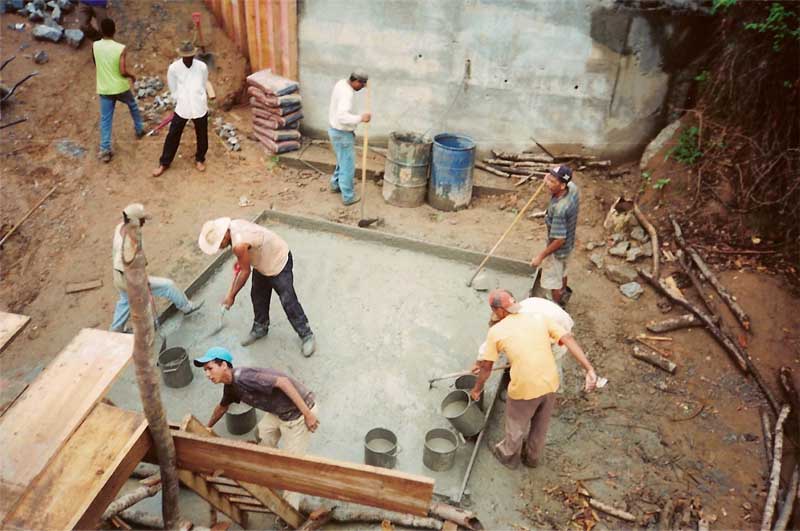
Once the blueprints were made, the question of the material returned. The peasants were unanimous: the mayor promised, so they would make him keep his promise. Continuous demonstrations in front of the city hall forced the unwilling mayor to release the necessary materials.
From the beginning until the end of the construction, not a single person was paid for their work to build it. The peasants from the area, that was at the time called “Para Terra I,” and other surrounding areas, as well as workers of Marreta Union (a union of civil construction workers from the capital of the state of Minas Gerais and base of the Worker’s League) and from other cities went daily to take part in the construction as collective and voluntary action. This required a lot of determination and a high level of political consciousness, as the peasants were still working in the fields, and the workers on construction sites—two tiring jobs.
From the beginning, women from the area joined the construction, saying that their role wasn’t solely to “cook and clean,” but to also take part in the construction. A collective decision was made so that every week, one day was a “women-only day” on the construction site. A youth-only day was also instituted.
As the construction advanced, some of the more skeptical peasants began to realize that the bridge was going to be built without the work of anyone but the peasants and workers themselves. When the mayor saw the progression of the project, he rushed to the site to boast that he was the one to thank because he allowed for the materials, they answered that it was their own taxes that paid those materials, and that it was workers and peasants leading the construction. They asked, “And you, what have you done?” Embarrassed, the mayor had no answer.
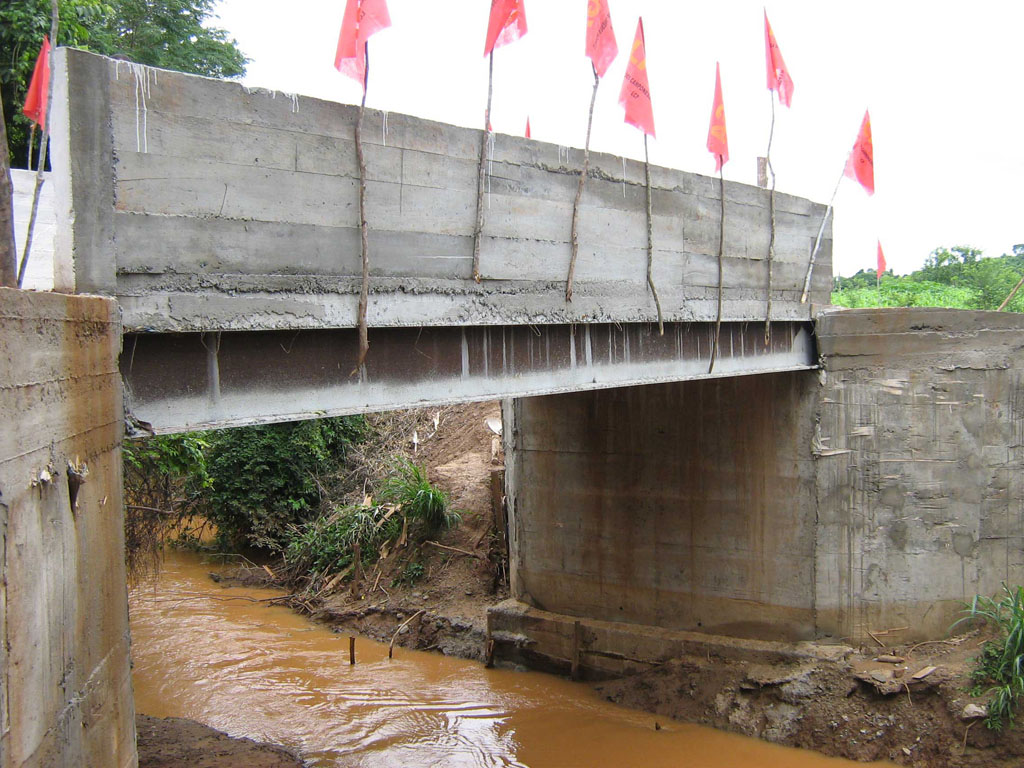
The construction of the bridge ended few months later. A solid bridge, capable of carrying a load of 30 tons, was built with an even more solid alliance of workers and peasants of the North of Minas. During its inauguration on December 9, 2006, comrades estimated that the sum of the days worked of the many participants would require 1800 days of voluntary work. The people’s assembly of the area decided to call it the “Worker-Peasant Alliance Bridge,” reflecting the real protagonists of its construction, making a plaque to commemorate the hard work of over 80 women and 300 men who took part in its construction. An LCP leader proclaimed: “Never again will we vote.”
One week after the inauguration, the mayor arrived at the bridge to make his own inauguration. No one attended. He also placed commemorative plaques, but what was written on them remains a mystery, as the following day they disappeared into the river.
Through this process, the peasants were able to see concretely how they would not be able to change the countryside of Brazil without the workers, just as the workers understood that the key for substantive change in their conditions was the peasant struggle for land and the destruction of the latifundio.
An Oasis in a Desert
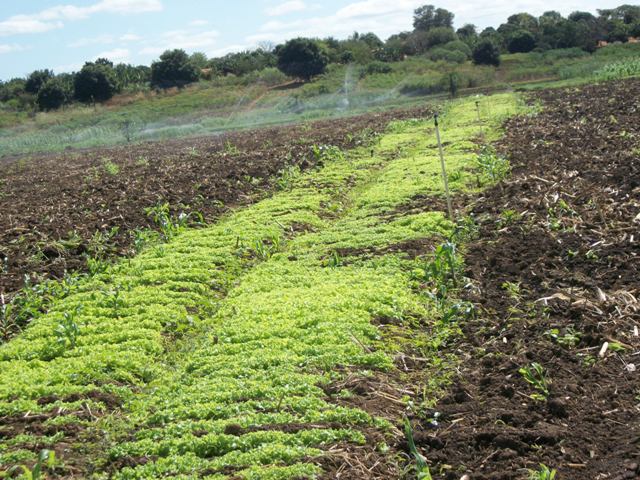
The region of North of Minas is considered a “tropical savanna with dry-summer” climate, meaning wet seasons for 5-7 months and dry seasons for 3-5 months. It’s a climate that is warm at all times of the year, with fertile soil that produces ample crops as long as they receive water. But with climate change, the region has longer and longer dry seasons. A lot of peasants had to abandon their lands as the prolonged droughts have had destructive consequences on their ability to produce self-sustaining crops. Without a costly irrigation system like the ones latifundio and agribusiness company have, yearlong production is prone to devastating crop failures.
But the peasants of the Bridge of the Workers-Peasants Alliance area learned through the construction of the bridge that they could do more than just passively wait for the worst to happen. Once again, it was the worker-peasant alliance that allowed them to do what opportunists would see as “too ambitious” and “too costly.”
The cost of the irrigation system was far less costly when divided by the 35 families of the area, but another issue appeared: how would they install a centralized irrigation system when each of the families had their different parcels of land far away from each other? This issue helped the peasants understand the necessity of putting together some of their parcels and cultivating them collectively. An area of 30 hectares was set aside for the collective field, and the work to install the irrigation system, designed by their comrades from the Workers’ League, was completed in 2011.
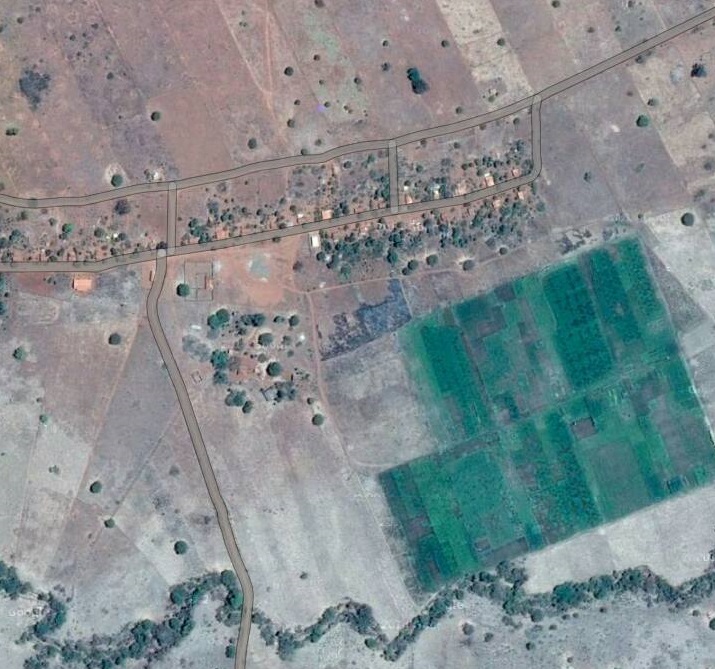 A co-operative was established to take care of the logistics such as buying a tractor. Currently, 16 of the 30 hectares are cultivated, with ongoing work to make the remaining 14 hectares arable. The production and the shares each family receives is decided collectively every year, with each family tasked to work with others on certain parcel sections of land. Apart from the collective land, the peasants still have their own parcels that they use for their personal needs. As a future goal, the peasants plan to develop a grain bank in order to be totally independent in grain.
A co-operative was established to take care of the logistics such as buying a tractor. Currently, 16 of the 30 hectares are cultivated, with ongoing work to make the remaining 14 hectares arable. The production and the shares each family receives is decided collectively every year, with each family tasked to work with others on certain parcel sections of land. Apart from the collective land, the peasants still have their own parcels that they use for their personal needs. As a future goal, the peasants plan to develop a grain bank in order to be totally independent in grain.
Since the unprecedented droughts in 2014, the collective land has become an oasis in a desert: a sea of green bursting with fruit trees, cassava, corn, beans and peppers in an otherwise barren landscape. There is not a single month that it doesn’t produce food.
Politicization as a key to develop broader unity among the oppressed
This area is an example of one of the most developed LCP revolutionary areas. Its achievements were not made with the money of a US NGO, or the actions of an opportunist mayor, but because the peasants internalized the necessity of the workers-peasants alliance.
The State deployed many efforts to crush the area. But the consequences of its strength can also be observed through its impact on the local economy; it is considered the largest producer of horticultural products in the region. Therefore, even the non-revolutionary elements of the region support it, because it would impact their own interests, and would oppose a brutal eviction.
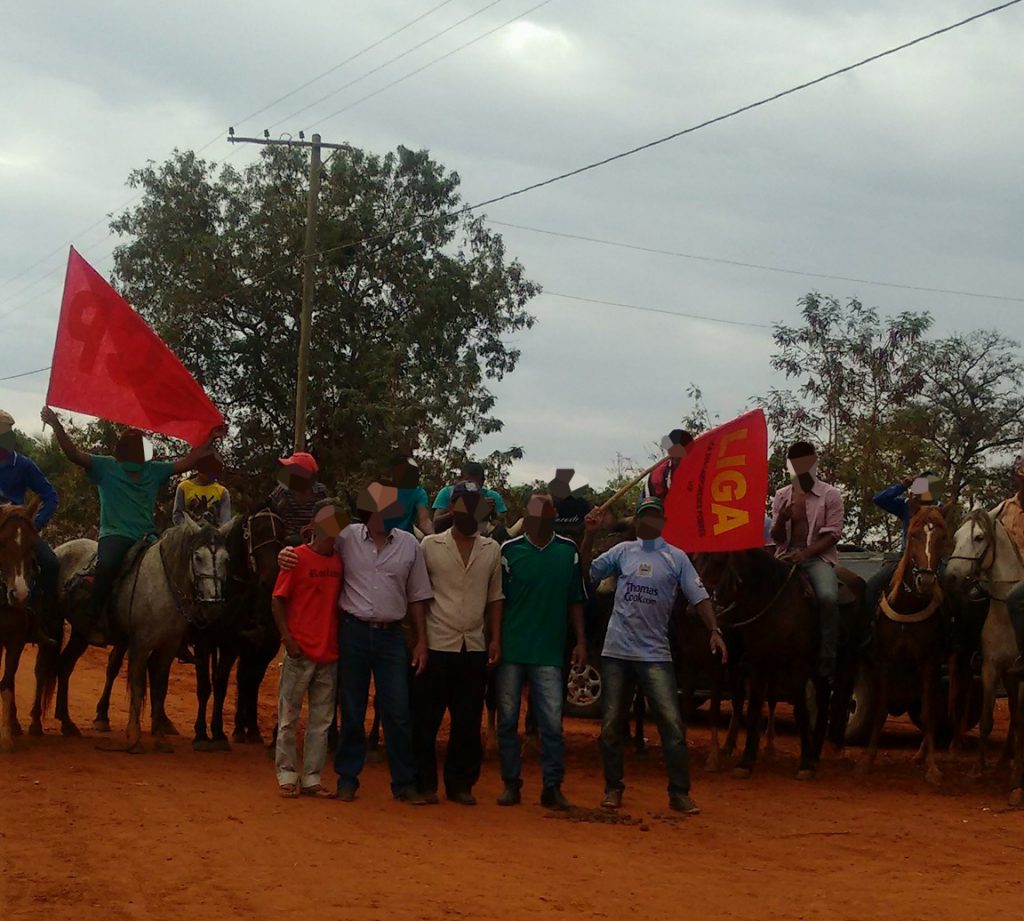 The State is trying different tactics to remove the peasants from their lands. A recent one has been the creation of the “Território Quilombola do Brejo dos Crioulos,” a territory that the State legally allowed Quilombo communities to be occupied, including the land of the Bridge of the Workers-Peasants Alliance revolutionary area. This gives the nearest Quilombo community the legal right to evict everyone else in the area, although the latifundists still hold the legal property titles.
The State is trying different tactics to remove the peasants from their lands. A recent one has been the creation of the “Território Quilombola do Brejo dos Crioulos,” a territory that the State legally allowed Quilombo communities to be occupied, including the land of the Bridge of the Workers-Peasants Alliance revolutionary area. This gives the nearest Quilombo community the legal right to evict everyone else in the area, although the latifundists still hold the legal property titles.
Pitting one oppressed community against another is an old trick of “putting masses against masses” that works well because of the racism and xenophobia that the dominant classes spreads to prevent their unity. Here, it didn’t work because of the level of consciousness of the community, the consequence of the LCP’s collective work and politicization, resulting in a decades-long struggle against discrimination. So the Quilombos and the peasants of the region have a close relationship with some intermarriage.
The regular attempts to defeat the comrades have been in vain; the revolutionary area has existed for 22 years and continues to develop its collective project.
4. Today’s situation
There are dozens of areas that have been seized by the LCP in different Brazilian states, each with different stages of development (mutual aid or cooperative). The communities living in the areas apply the line of “Nosso Caminho,” which creates a high level of political unity among them, despite some areas being distant from others, some separated by several thousands of kilometers.
 The movement is now facing a situation where the opportunists, incapable of solving the problems of the crisis of the decomposition of bureaucratic capitalism in the country aggravated by the current international economic crisis, have been replaced by the government of the fascist Bolsonaro, which has encouraged the massacres of poor peasants and oppressed minorities (mainly the indigenous and Quilombos) with the creation of a special military force tasked with the repression. The use of armed vehicles and even helicopters in evictions has become common.
The movement is now facing a situation where the opportunists, incapable of solving the problems of the crisis of the decomposition of bureaucratic capitalism in the country aggravated by the current international economic crisis, have been replaced by the government of the fascist Bolsonaro, which has encouraged the massacres of poor peasants and oppressed minorities (mainly the indigenous and Quilombos) with the creation of a special military force tasked with the repression. The use of armed vehicles and even helicopters in evictions has become common.
Against the increase in the brutality of the evictions, the LCP increases the level of resistance and seeks greater unity within all the strata of the oppressed masses, such as the ones affected by mining, construction of dams, cultivation of homogeneous forests (eucalyptus), including the urban worker’s masses.
The situation in the country necessitates an increase in the struggle’s intensity; the subjective conditions have shown through its 25 year-long history of struggle that it is capable of resisting and of raising the consciousness of the masses. Those two factors propel the peasant movement in Brazil toward a qualitative leap in its struggle for the Agrarian Revolution.
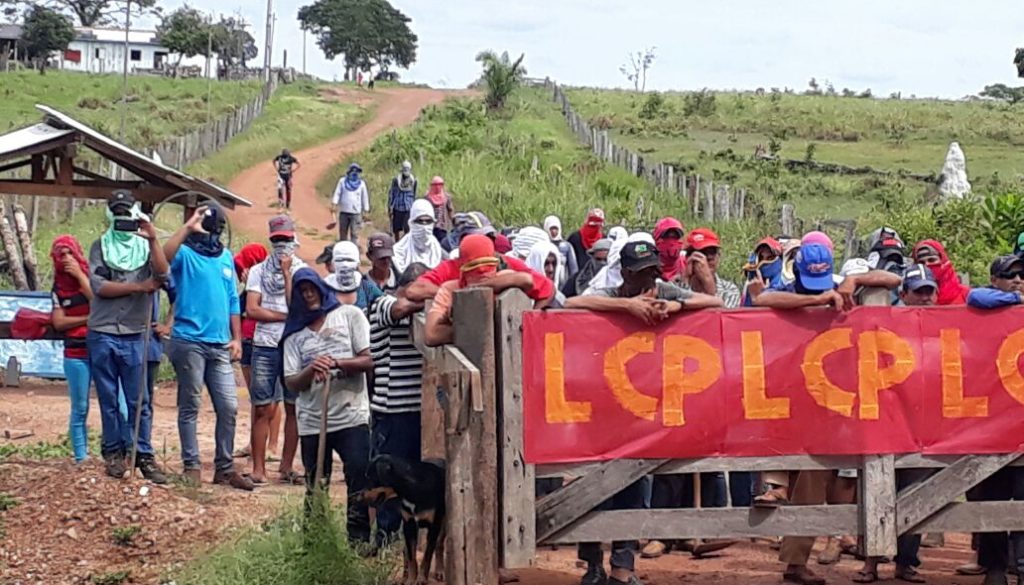
References
Revolutionary sources
- LCP, “Nosso Caminho,” 2001, revised in 2018
- Inaugurada a ponte do povo!, A Nova Democracia, February 2007
- Carta Aberta: Em defesa das famílias camponesas do Para Terra I/Varzelândia, Resistencia Camponesa, February 2013
Other sources
- Brazil: Corumbiara and Eldorado de Carajas: rural violence, political brutality and impunity, Amnesty International, January 1998
- Revisiting Agrarian Reform in Brazil 1985-2016, Wilder Robles, 2018
- The changing climate of Minas Gerais, C&CI, March 2014
- Evolution of land rights in rural Brazil, Rita Damasceno, Joana Chiavari, Cristina Leme Lopes, April 2017
- Towards Efficient Land Use in Brazil, Juliano Assuncao, Joana Chiavari, New Climate Economy Report, 2014
Art credit
- Brazilian artist Antonio Kuschnir

